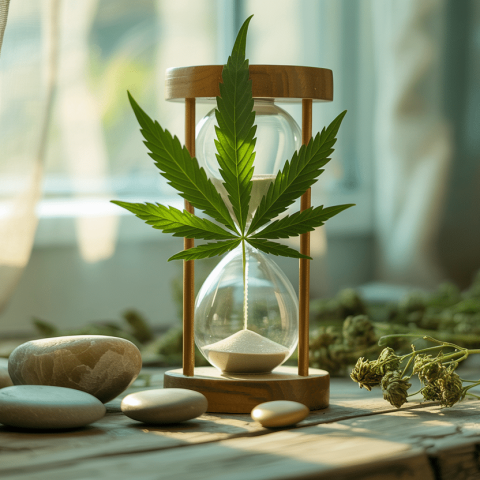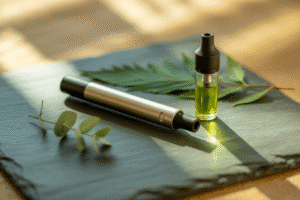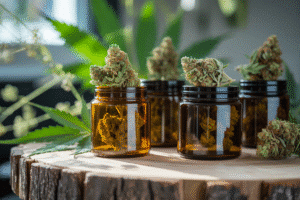- What to Expect During Your Tolerance Break
Cannabis Tolerance Breaks: Strategic Reset Guide 2025

Contents
Contents
If you’ve been using cannabis regularly and noticed you need more to feel the same effects, you’re experiencing one of the most common phenomena in cannabinoid pharmacology: tolerance. According to research published in the Journal of Neuroscience, regular cannabis use leads to downregulation of CB1 cannabinoid receptors in the brain, reducing sensitivity to THC by up to 20% in chronic users. As cannabis becomes increasingly integrated into wellness routines across Greece and Europe, understanding tolerance management isn’t just about saving money—it’s about maintaining the therapeutic and recreational benefits that drew you to cannabis in the first place.
Whether you’re using cannabis for chronic pain management, sleep support, or simply unwinding after work in Athens, tolerance breaks (or “t-breaks”) offer a science-backed strategy to reset your endocannabinoid system and restore your original sensitivity. This comprehensive guide explores the neuroscience behind tolerance, provides day-by-day timelines of what to expect, and offers practical strategies for successfully navigating a tolerance break.
Understanding Cannabis Tolerance: The Science Behind Diminishing Effects
Cannabis tolerance develops through a well-documented neurobiological process. When THC binds to CB1 receptors in your brain repeatedly, your body responds by reducing the number of available receptors—a process called “downregulation.” Research from the National Institute on Drug Abuse shows this adaptation can occur within just days of consistent use, though the degree varies significantly based on consumption frequency, potency, and individual biology.
The endocannabinoid system (ECS) naturally produces compounds like anandamide that maintain homeostasis throughout your body. When you introduce external cannabinoids regularly, your ECS essentially says “we’re getting plenty of stimulation from outside sources, so we’ll dial back our receptor availability.” This is why that 10mg edible that once gave you a pleasant evening now barely registers, or why your favorite strain no longer delivers the relief it used to.
💡 Key Science: How Tolerance Develops
Your endocannabinoid system adapts to regular cannabis use through several mechanisms:
- CB1 receptor internalization (receptors move away from cell surface)
- Reduced receptor density in brain regions (hippocampus, prefrontal cortex, striatum)
- Decreased receptor sensitivity to cannabinoid binding
- Changes in downstream signaling pathways
Studies using PET imaging have shown that daily cannabis users have significantly fewer available CB1 receptors compared to non-users, with the most pronounced differences in brain regions responsible for memory, reward, and executive function.
Signs You Need a Tolerance Break
Not everyone develops tolerance at the same rate, and recognizing when you’ve hit that threshold is the first step. Research indicates tolerance manifests differently for various cannabis effects—tolerance to the cognitive and psychoactive effects develops faster than tolerance to appetite stimulation or some therapeutic properties.
Common Tolerance Indicators
- ✓ You’re consuming significantly more than when you started
- ✓ Effects feel weaker or shorter-lasting
- ✓ You need to use cannabis more frequently throughout the day
- ✓ Your cannabis budget has increased substantially
- ✓ You’re experiencing diminished therapeutic benefits
- ✓ You feel dependent on cannabis to function normally
- ✓ Withdrawal symptoms appear when you try to cut back
A study published in Drug and Alcohol Dependence found that approximately 47% of daily cannabis users report tolerance as a significant concern, with many expressing frustration at needing increasingly larger doses to achieve desired effects.
⚠️ Important Consideration
Tolerance is distinct from dependence, though they often occur together. If stopping cannabis causes significant withdrawal symptoms (irritability, insomnia, appetite changes, anxiety), you may have developed cannabis dependence alongside tolerance. This doesn’t make you a “bad person”—it’s a predictable physiological response. However, it does mean your tolerance break may require additional support and a more gradual approach.
The Science of Tolerance Reversal: What Happens During a Break
The good news: tolerance reversal is well-documented and relatively predictable. A landmark study from Biological Psychiatry examined CB1 receptor availability in abstinent cannabis users using brain imaging and found that receptor levels begin recovering within 48 hours of cessation, with near-complete normalization occurring around 28 days for most users.
However, the timeline varies based on several factors:
💡 Factors Affecting Recovery Time
- Consumption pattern: Daily users require longer breaks than weekend users
- Potency: High-THC concentrates may require longer recovery than flower
- Duration of use: Years of daily use needs more time than months
- Individual biology: Metabolism, age, and genetics all play roles
Research from the Journal of Psychopharmacology suggests that even a short 48-hour break can produce measurable improvements in receptor sensitivity, though longer breaks produce more dramatic and lasting results.
Optimal Tolerance Break Duration: What Research Shows
While social media often suggests arbitrary timeframes (“just take a week off”), actual research provides more nuanced guidance. A comprehensive review in Addiction Biology analyzed multiple studies on cannabis tolerance and abstinence, revealing several key findings:
Research-Backed Break Durations
- Minimum effective break: 48-72 hours shows measurable improvement
- Standard reset: 21-28 days produces significant receptor upregulation
- Complete normalization: 4-6 weeks for heavy daily users
- Maintenance approach: 2 days off per week can prevent tolerance buildup
For most regular users, a 21-day tolerance break represents the sweet spot—long enough to produce meaningful receptor recovery without requiring an extended period of abstinence. However, very heavy users (multiple times daily, high-potency products) may benefit from 30-45 days for optimal results.
💡 Personalized Timeline Guide
Match your t-break duration to your usage pattern:
- Occasional users (1-2x weekly): 3-7 days sufficient
- Regular users (3-4x weekly): 14-21 days recommended
- Daily users (once per day): 21-28 days optimal
- Heavy daily users (multiple times daily): 30-45 days for full reset
Day-by-Day Timeline: What to Expect During Your Tolerance Break
Understanding the typical progression helps you prepare and persist through challenging moments. While individual experiences vary, research on cannabis withdrawal and receptor recovery reveals common patterns:
Tolerance Break Timeline
Days 1-3: The Adjustment Phase
Your body begins immediate adaptation. You may experience:
- Sleep disruption (difficulty falling asleep, vivid dreams)
- Mild irritability or mood changes
- Appetite fluctuations
- Restlessness or low energy
CB1 receptors begin upregulating within 48 hours.
Days 4-7: The Challenge Week
Withdrawal symptoms typically peak around day 5-6, then begin subsiding:
- Sleep often remains disrupted but gradually improves
- Mood stabilizes somewhat
- Cravings may intensify as habits are broken
- Physical discomfort (headaches, mild nausea) possible
This is the crucial persistence period. Those who make it past day 7 have significantly higher success rates.
Days 8-14: Turning the Corner
Noticeable improvements emerge:
- Sleep quality begins normalizing
- Natural energy returns
- Mood becomes more stable
- Cravings decrease in frequency and intensity
- Mental clarity improves
Days 15-21: The Sweet Spot
Most physiological withdrawal symptoms have resolved. Sleep returns to baseline, appetite normalizes, mood feels stable. Significant CB1 receptor recovery has occurred.
Days 22-30: Complete Reset
For most users, receptor density has normalized substantially. All withdrawal symptoms typically resolved, natural endocannabinoid system functioning restored, full sensitivity reset achieved.
Strategies for a Successful Tolerance Break
Research on substance use behavior change provides evidence-based approaches that significantly improve tolerance break success rates:
💡 1. Set a Specific, Measurable Goal
Studies show that concrete goals (“I will abstain for 21 days starting Monday”) succeed far more often than vague intentions (“I should probably cut back”). Write your start date, end date, and specific reasons for taking the break.
💡 2. Remove Triggers and Access
Behavioral research confirms that environmental cues strongly predict relapse. Remove cannabis products from your home, delete delivery app shortcuts, and inform your social circle about your break. One study found that removing immediate access reduced use attempts by 67%.
💡 3. Substitute, Don’t Just Subtract
Cannabis likely fills specific needs in your routine. Research on habit formation shows replacement behaviors succeed better than simple elimination. Consider:
- Evening cannabis for relaxation → Herbal tea, meditation, or CBD-only products
- Cannabis for sleep → Magnesium supplements, sleep hygiene improvements
- Social cannabis use → Alternative social activities during your break
- Cannabis for boredom → New hobbies, exercise, creative projects
💡 4. Leverage CBD During Your Break
An interesting finding: CBD doesn’t produce tolerance the same way THC does, and it may actually help manage cannabis withdrawal symptoms. Research in Neuropsychopharmacology suggests CBD can reduce anxiety and improve sleep during THC abstinence without interfering with receptor recovery.
💡 5. Exercise and Sweat
THC metabolites are stored in fat cells and released gradually. Studies show that exercise may accelerate clearance and improve mood during withdrawal through endorphin release. Aim for 30-45 minutes of moderate activity most days.
💡 6. Stay Accountable
Research on behavior change consistently shows that accountability structures improve success. Tell a friend, use a tracking app, or journal daily about your experience and motivations.
⚠️ When to Seek Support
For some long-term heavy users, cannabis dependence may require professional support. Consider reaching out to a healthcare provider if you experience:
- Severe anxiety or depression during your break
- Inability to sleep after 7+ days
- Intense physical symptoms
- Thoughts of self-harm
- Inability to function at work or in relationships
Cannabis Use Disorder is recognized by the World Health Organization and is treatable. Seeking help is a sign of self-awareness, not weakness.
Returning After Your Tolerance Break: Start Low, Go Slow
After successfully completing your tolerance break, your receptor density has significantly increased—meaning you’ll be much more sensitive to THC than before. Research on tolerance reversal emphasizes the importance of strategic reintroduction to maintain your reset and prevent rapid re-tolerance.
First Use Guidelines
Start with 25-50% of your previous dose. If you previously used 20mg edibles, start with 5-10mg. If you smoked half a joint, try just a few puffs. Multiple studies document cases of users experiencing uncomfortably intense effects after tolerance breaks because they resumed at their old dosage.
💡 Preventing Rapid Re-Tolerance
Research shows that daily use rapidly re-establishes tolerance, but strategic moderation can maintain sensitivity:
- Limit use to 3-4 days per week maximum
- Take regular 48-hour breaks (every weekend or mid-week)
- Vary your consumption (don’t use the same amount at the same time daily)
- Consider a “maintenance protocol” of lower doses more strategically
A study in Cannabis and Cannabinoid Research found that users who implemented structured moderation after tolerance breaks maintained 70% of their sensitivity improvements after 6 months, compared to just 20% for those who immediately resumed daily use.
Local Resources and Support in Greece
As cannabis wellness becomes more mainstream in Athens and across Greece, resources are expanding. While THC-containing cannabis remains controlled, legal CBD products can serve as useful alternatives during tolerance breaks.
Puff ‘n Pass offers a range of CBD products that can support your tolerance break journey—from CBD oils for anxiety management to CBD sleep aids that don’t interfere with CB1 receptor recovery. Our knowledgeable staff understands tolerance management and can recommend appropriate products based on your specific needs.
Winter Wellness at Puff ‘n Pass
Whether you’re planning a tolerance break or looking for CBD alternatives to support your reset journey, Puff ‘n Pass is here to help. Our Athens location offers a curated selection of premium CBD products, knowledgeable staff who understand tolerance management, and a judgment-free environment where your wellness goals come first.
Visit our shop to explore CBD oils, sleep aids, and other products that can support your tolerance break, or check out our FAQ for more information about navigating cannabis wellness in Greece.
📝 Legal Disclaimer
This article is for informational and educational purposes only and does not constitute medical advice. Cannabis laws vary by country and region—THC-containing cannabis products remain controlled substances in Greece, while CBD products with less than 0.2% THC are legal. Always consult with a qualified healthcare provider before making changes to your wellness routine, especially if you have underlying health conditions or take prescription medications. The information about tolerance breaks is based on current research but individual experiences vary significantly. If you experience severe withdrawal symptoms or struggle with cannabis dependence, please seek professional support from addiction specialists or mental health providers.




